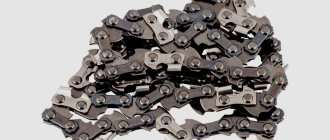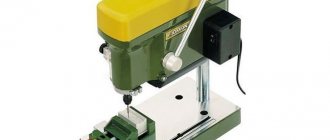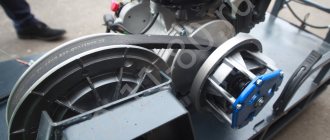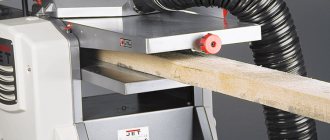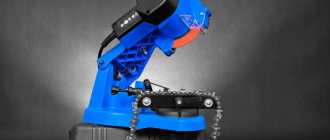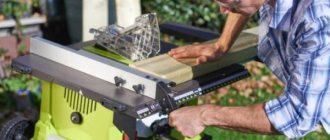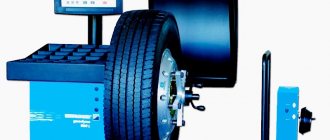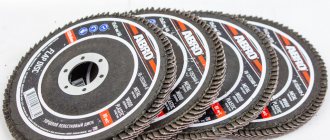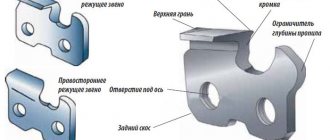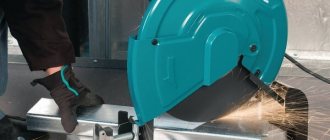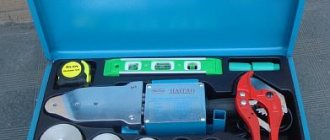The chainsaw is actively used not only for industrial purposes during construction and felling of forests, but also for domestic needs or in the country. With intensive use, it wears out, and its main cutting element, the chain, is the first to be hit.
However, constantly buying new chains is expensive, so you can buy a machine to restore the old one. Such a unit does not belong to high-tech equipment, but choosing a reliable model is not as simple as it seems.
Below is a classification of devices for sharpening gasoline saws, principles of operation, characteristics, descriptions, the study of which will help you answer what the options are, how to choose the right model, and also where to buy the best machine.
Reasons for the need to sharpen a chain
The chain has a simple design of links with teeth. They have a complex geometric shape with two perpendicularly located incisors, which perform:
- cut of the sawn surface;
- removal of chips, as well as ensuring the width of the cut.
The material is steel with a chrome coating applied on top.
Causes of dull teeth:
- intensive use of a chainsaw;
- hit by metal objects;
- improper operation;
- interaction with hard rocks.
All chainsaws require sharpening, regardless of brand or price.
It is unsafe to use a dull tool. Cutting times slow down, gas mileage increases, and increased vibration damages the frame.
Consequences of using non-standard equipment
Attempts to use an electric sharpener or grinder to fine-tune chains most often do not give the desired result. Even with certain skills, this technology does not guarantee the same sharpening angles and the same height of the stops.
Improper sharpening inevitably leads to decreased performance, increased vibration levels, and additional loads on the power drive. A slightly better result is obtained by a homemade machine made on the basis of a manual or electric sharpener.
Operating principle and classification
The design is similar to a mounting saw with a grinding disc in a hanging head mounted on a support frame instead of a cutting disc.
A rotary vice fixes the saw part, and each tooth is sequentially processed with a supplied sharpener. The required angle is independently set by the operator according to the step between the links. As a rule, the thickness of the circle is 3.5 – 4.0 mm.
Safety is achieved by securely securing the tool to the workbench.
In order to process each link as sharply as possible, the disk must be positioned perpendicular to the chain. You can extend the service life by individually editing each tooth.
It should be remembered that the machine also levels the chainsaw blade. For this purpose, the smallest tooth is selected, to which all the others are adjusted. With the same dimensions, the load on the internal mechanism is reduced. In addition, alignment prevents the links from falling apart.
PATRIOT 220V PG-MG220
Main characteristics:
- Grinding wheel rotation speed - 4800 rpm;
- Motor power - 85 W;
- Disc diameter - 108 mm;
- Circle thickness - 3.2 mm;
- The bore diameter is 22.2 mm.
Design features. This machine belongs to household class equipment. It is intended for stationary installation on a horizontal surface, for which holes are made in the base. It has an 85W motor, which is the norm for 108x3.2mm abrasive discs. Mounting hole 2.2 mm. The power cable at the connection point has a thickening that prevents breakage.
Functionality and ease of use. The working head of the machine moves in one plane. To manipulate it, there is a raised protrusion on the body of the product. The start key is also located there. There is an adjustable stop that limits the stroke at the cutting site.
Adjustable stop.
Sharpening occurs at a speed of 4800 rpm. The vice is equipped with a side clamp and a longitudinal chain clamp. They can be set to any angle, focusing on a clear scale. Fastening in the selected position is carried out using a screw with a wide handle.
Side clamp with scale.
Safety. To protect the master, there is an emery wheel casing with a transparent insert in the working area.
Protective cover with transparent insert.
Pros of PATRIOT 220V PG-MG220
- Light weight and compact dimensions.
- High quality build.
- Simple design.
- Permissible noise level.
- Easy to make settings.
- Possibility of using grinding wheels with a common diameter of 108 mm and a width of 3.2 to 4.8 mm.
- Reasonable price.
Cons PATRIOT 220V PG-MG220
- Plastic body.
- There is not enough local lighting.
Types of machines
Classification is carried out according to several parameters.
1. By drive:
- manual;
- electric.
2. By application:
- portable (mobile);
- stationary.
3. On energy supply:
- power supply 220 V;
- 12 V car battery.
4. By management:
- manual (semi-automatic);
- automatic.
Manual machines: Purpose and principle of operation
They are mechanical devices similar to a bow saw, in the form of a frame with a file attached to a chainsaw. The desired angle is set by a simple adjustment system. The depth is determined by the most worn tooth and maintained throughout the cycle.
The operation is performed by performing back-and-forth movements with the hands using a file. The efficiency of the process increases when processing first one side, then the other.
A high-quality result requires skill. Intuition and eye are of particular importance. Cooling is carried out with compressed air, after which it is immersed in engine oil.
The popularity of models is determined by the presence of advantages and the absence of disadvantages.
Advantages
- Low price when compared with electric ones;
- Ease of use;
- Small weight and size values that do not create problems during transportation;
- Compatible with any suitable files;
- Independence from power supply or complete autonomy;
- No risk of overheating;
- Minimal grinding of the cutter, which extends the service life.
Flaws
- Low productivity and labor-intensive process;
- Impossibility of maintaining an ideal angle;
- The need to count the number of file passes;
- Requirement of specific skills and knowledge of the design, angles, and abrasive sharpener used.
Not applicable to chains consisting of carbide dust links.
Semi-automatic electric machines: Composition and operating procedure
Main components:
- a bed with a fixed vice, where the guide slides are installed, as well as a depth limiter, an angle scale, a start button, and other equipment;
- asynchronous motor and abrasive sharpener on the spindle;
- clamp with fasteners.
The movable mount allows position adjustment for correct angle setting. The saw chain is placed on the slide. An attached stop plate adjusts the depth of cut. Thanks to the adjustment screw, it extends, increasing the turning depth.
Sharpening stages:
- Placing the chain in a vice on a slide.
- Rotate on a graduated scale to the required angle.
- Securing with a stopper.
- Setting the required groove depth.
- Starting the engine and moving the sharpener by the handle to the cutter to the specified depth.
- Lifting the motor head up and turning off the power.
- Unfastening and moving the link.
- Repeating the process.
After the process is completed on one side, the teeth are checked with a gauge. The chain is then turned over and the operation continues for the other side.
The device must be configured before use. Instructions are included with the kit.
Advantages
- Good performance;
- High speed;
- Ability to align teeth one by one;
- Universal functionality;
- Excellent sharpening angle with adjustability;
- Partial automation;
- Backlight;
- High security;
- Budget models with affordable prices;
- Connection to mains or battery.
Flaws
- Mandatory skills for the operator;
- The need to replace discs due to wear;
- Lack of consideration of the characteristics of each link, as well as its wear;
- Reduced resource due to a single template applied to all links.
Automatic machines
Specially designed units for the main sharpening cycle without an operator in large sawmills or repair plants. Human involvement is limited to circuit placement as well as parameter setting.
Hydraulic actuators, controlled by a controller, move the working components. Sharpening is performed simultaneously with two heads:
- from above - cutting;
- on the side – depth limitation.
The speed increases due to one pass because the upper head interacts with all the teeth in turn.
Homemade devices
If you need daily sharpening, you can make homemade sharpening devices with your own hands. These can be electric motors with an abrasive disc attached to the shaft.
The engine power should be small, and it itself should be fixed on the frame. The chain is secured with a special template, and a motor with a rotating sharpener is manually driven to each tooth.
The material being processed must be securely fixed and the motor must be movable.
How to make this type of device is clearly explained on the Internet. There you can also find out how much it costs to convert grinders or other power tools into branded units that can restore old chains.
Video tutorial “Homemade machine for sharpening saw chains”:
Which company is better to choose?
The domestic market offers many models of electric machines for sharpening saw chains, which differ in workmanship, performance and functionality. Based on user reviews and expert opinions, we have compiled a small rating of companies that produce the best chain sharpening machines.
- DIOLD . Domestic manufacturer of hand and power tools. The machines and consumables produced at the company's factories are distinguished by their build quality and low price. In addition, DIOLD has a developed network of service centers providing warranty and post-warranty service. A sharpening machine of this brand will be the optimal choice for household maintenance of saw chains;
- Oregon _ North American manufacturer of gasoline chain saws and accessories. Its own design department and constant quality control of its products allowed the company to gain the authority of users. Machines manufactured under the Oregon brand are distinguished by productivity, reliability and advanced functionality. They are great for professional and commercial use;
- Einhell . The company is engaged in the production and servicing of hand and power tools. It has long been known to domestic users and is very popular. Machines produced by Einhell combine productivity, workmanship and cost of goods. Therefore, they are equally suitable for both domestic and commercial use.
Practical recommendations for choosing
Before choosing which machine is best to buy, you need to get acquainted with this tool by studying the technical parameters and ratings, and also listen to expert advice on what to pay attention to. It is necessary to present the basic principles of operation, as well as determine the planned volumes in advance.
Main selection criteria
1. Nature and operating conditions:
- landline or mobile;
- manual or semi-automatic (automatic).
2. Price.
If you use it infrequently, there is no point in buying an expensive professional model.
3.Technical parameters:
- RPM demonstrates speed and sharpening qualities. For occasional use, 3000 rpm is sufficient. For daily use or large volumes, it is advisable to consider tools with values up to 7.5 thousand rpm;
- The size of the abrasive disc determines the purpose: up to 145 mm - manual models, up to 250 mm - stationary devices, up to 400 mm - industrial units.
- power determines the frequency of use and mobility: up to 220 W are popular models for household devices, and professional ones are equipped with more powerful electric motors to increase load resistance.
4. Equipment with additional functions:
- rotation of the grinding head or clamping block;
- cooling system;
- wet grinding;
- tension regulation;
- backlight;
- additional functions of a specific product.
5. Complete set:
- the product itself;
- grinding discs of different thicknesses;
- calibers;
- additional keys;
- instructions, manuals, reviews.
6. Security:
- casing;
- additional screen;
- clear insert material for control and protection;
- automatic power off.
Review of popular models
To reduce the time spent searching for a suitable device, we reviewed and compiled a rating of machines for sharpening chainsaw chains.
Rating of stationary models with electric drive
Below is a rating of the most popular stationary models of electrically driven machines.
Rezer EG180-C
Stationary electric sharpening machine for household use. A powerful electric motor, metal drive gear and build quality make it possible to use it for sharpening chains with link pitches from ¼ to 0.405 inches. A housing made of impact-resistant plastic with wide heat exchange holes reliably protects the internal components of the machine from mechanical damage. The cast metal base allows you to reduce the overall level of vibration, and the technological holes located in the corners make it possible to fix it on any surface.
The high rotation speed of the sharpening disc ensures high-quality sharpening of teeth. The machine is equipped with a rotary vice for fixing saw chains up to 2 mm thick. This makes it easier to carry out work and increase its accuracy.
Specifications:
- manufacturer - Rezer;
- model – EG180-C;
- The homeland of the brand is Russia;
- country of origin – China;
- class - household;
- power, hp/kW – 0.24/0.18;
- disk diameter, mm – 100;
- spindle speed, rpm – 6000;
- disc thickness, mm – 4.5;
- weight, kg – 2.3;
- price, in rubles – 2,490.
| Advantages | Flaws |
| ease of operation | noisy during operation |
| changing the angle of the sharpening disc | |
| high performance |
DIOLD MZ-0.13
Compact household chain sharpening machine. Designed for sharpening saw chains with different link pitches. The single-phase, double-insulated commutator motor spins the grinding wheel up to 2500 rpm. This indicator is quite sufficient for straightening the edge of a cutting tooth at home. To protect the electric motor from shock loads, the grinding wheel is driven through a V-belt drive.
The ergonomically shaped handle provides a comfortable grip and securely holds the tool in the user's hand. The massive supporting surface allows you to securely fix the unit on any surface.
Design features allow the vice to rotate 30⁰ in both directions, facilitating the sharpening process.
Specifications:
- manufacturer – DIOLD;
- model – MZ-0.13;
- The homeland of the brand is Russia;
- country of origin – China;
- class - household;
- power, hp/kW – 0.18/0.13;
- disk diameter, mm – 100;
- spindle speed, rpm – 2500;
- disc thickness, mm – 3.5;
- weight, kg – 2.0;
- price, in rubles – 2,907.
| Advantages | Flaws |
| good build quality | low spindle speed |
| double insulation of electric motor | |
| adjustable sharpening angle of cutters |
After watching the video, you can see a full overview and assembly process of the DIOLD MZ-0.13 chain sharpening machine.
Huter ESC-100
Universal household machine for sharpening chainsaw chains. Simplicity of design increases reliability and simplifies device management. The housing with additional stiffening ribs provides reliable protection of the internal elements. The single-phase electric motor ensures stable spindle rotation at 5200 rpm. Wide ventilation holes effectively remove heat, protecting the motor from overheating and extending its trouble-free operation.
A special feature of the design is the ability to change the angle of inclination of the grinding disc. Together with the adjustable clamping vice, this factor increases the accuracy and speed of dressing the cutting teeth.
Specifications:
- manufacturer - Huter;
- model – ESC-100;
- The homeland of the brand is Germany;
- country of origin – China;
- class - household;
- power, hp/kW – 0.14/0.1;
- disc diameter, mm – 108;
- spindle speed, rpm – 5200;
- disc thickness, mm – 4.5;
- weight, kg – 2.37;
- price, in rubles – 3,090.
| Advantages | Flaws |
| small dimensions and weight | plastic bed |
| simplicity of design | |
| long service life |
We also recommend reading an interesting article about how to sharpen a chainsaw chain with your own hands.
Whirlwind SCZ-200
Portable chain sharpening machine for chain pitches from ¼" to 0.404". The plastic body and specially shaped handle make the tool easier to use and also protect the internal elements from mechanical damage. The grinding wheel rotates at a frequency of 6000 rpm, which allows for high-quality sharpening of saw teeth.
The massive cast aluminum alloy base reduces vibrations that occur during operation.
For added convenience, the machine is equipped with a rotating vice, into which you can clamp a chain up to 1.6 mm thick.
Specifications:
- manufacturer – Whirlwind;
- model – SCZ-200;
- The homeland of the brand is Russia;
- country of origin – China;
- class - household;
- power, hp/kW – 0.27/0.2;
- disk diameter, mm – 100;
- spindle speed, rpm – 6000;
- disc thickness, mm – 3.2;
- weight, kg – 2.36;
- price, in rubles – 3,090.
| Advantages | Flaws |
| powerful electric motor | presence of assembly gaps |
| high performance | |
| long service life |
Zubr STs-200
High-performance machine for sharpening household and professional saw chains with 1/4 and 3/8 inch link pitches. A special feature of the design is a drive gearbox that perfectly regulates speed. Therefore, a 90 W electric motor easily spins the disk spindle up to 5000 rpm. This is enough for high-quality straightening of the cutting edge of any saw chain. In addition, the package includes two discs of different thicknesses, thanks to which you can sharpen a variety of saw chains.
The rotary vice is equipped with a quick chain release function. Thanks to this, it was possible to increase the speed of work.
Specifications:
- manufacturer – Bison;
- model – STs-200;
- The homeland of the brand is Russia;
- country of origin – China;
- class – semi-professional;
- power, hp/kW – 0.12/0.09;
- disc diameter, mm – 104;
- spindle rotation speed, rpm – 5000;
- disc thickness, mm – 3.2;
- weight, kg – 2.75;
- price, in rubles – 3,990.
| Advantages | Flaws |
| reliable electric motor | plastic chain link stopper |
| sharpening depth limiter | |
| swivel blade lock |
Summary comparison table
For greater clarity, the main parameters of the machines were summarized in a single table. Looking at it, it’s easier to understand which machine for sharpening chainsaw chains is better.
| Name | Electric motor power, kW | Disc diameter, mm | Spindle speed, rpm | Disc thickness, mm | Cost, rub |
| Rezer EG180-C | 0,18 | 100 | 6000 | 4,5 | 2 490 |
| DIOLD MZ-0.13 | 0,13 | 100 | 2500 | 3,5 | 2 907 |
| Huter ESC-100 | 0,1 | 108 | 5200 | 4,5 | 3 090 |
| Whirlwind SCZ-200 | 0,2 | 100 | 6000 | 3,2 | 3 090 |
| Zubr STs-200 | 0,09 | 104 | 5000 | 3,2 | 3 990 |
We also recommend reading an interesting article about the 3 most popular ways to sharpen a power saw chain at home.
Summarizing
Thus, the best machine is a device that meets the stated requirements in all respects and has positive reviews from users. By comparing the parameters of most products, you can choose an excellent option, new items from universal models at an affordable price.
It is important not to make mistakes when choosing. It should be remembered that the Russian supply market is almost 20% filled with counterfeits from China, copying the external forms of instruments from recognized manufacturers. Therefore, buying a cheap machine made by unknown craftsmen may turn out to be a bad purchase. In this case, it will not meet the requirements and will not provide warranty obligations.
The question of which company’s product is best to buy can only be resolved by contacting stores or representative offices of trusted companies that have the necessary licenses. The best manufacturers value their reputation.
Enjoy the shopping!
How to make it yourself
In this paragraph, we’ll look at how to create your own machine for sharpening chainsaw chains with your own hands at home.
Materials:
- Engine.
- Grinding wheel.
- Grinding wheel fasteners.
- Sheet steel.
- Switch.
- Wiring is insulated.
- Construction corner.
- Various small items (bolts, nuts, screws).
- Engine. Motors from old washing machines are actively used in sharpening machines. When searching for a motor, it is important to take into account the power; it must be compared with the diameter of the grinding wheel. The larger the diameter of the circle, the greater the torque the motor shaft must develop, otherwise the circle may stop under load. In purchased versions of the machines, a 250 W motor rotates the circle by 200 mm, these figures should be approximately adhered to. Of course, it is better for the machine to have a power reserve, but do not forget that the grinding wheel will decrease in diameter as it wears out.
- Base and circle. We prepare a reliable base for the sharpener (the simplest frame is made from a corner and sheet steel). We make reliable fasteners for the motor; it needs to be screwed with bolts and nuts. Grovers and nuts with plastic locking rings will not be superfluous. Many people immediately install a grinding wheel on the motor shaft; here they need to select a plus and make bushings depending on the diameter of the wheel. The circle is usually clamped with large washers on both sides; it would be a good idea to place cardboard spacers under the washers.
- Protection. Next, you need to create a special protective frame, the installation of which takes no more than twenty minutes, but during the process of sharpening something you will not be bombarded with various consumables. In this case, the protective shield is welded into the frame where necessary, secured with ordinary metal rods, pipes, and brackets.
- Emphasis. To make it comfortable and safe to work on the machine, we put emphasis on it. The emphasis must be adjusted in at least two positions - vertically and horizontally. It will move towards the grinding wheel as it wears out, and will be used in other equally important stages of work. We assemble the stop from a corner, plates and sheet steel, and we find the drawings on the Internet or invent them ourselves, since the mechanism is simple. You can also weld pipes to the nuts, and insert steel rods into the pipes as the main handles - it will be much more convenient to use the device.
- Shield cover. We are making a cover for the shield; it should be removable so that the circles can be replaced as needed. We cut out the cover itself from sheet steel and drill holes in it. We weld bolts or threaded rods to the shield itself; as a result, the cover will be secured with nuts. It would be a good idea to make a window at the bottom of the shield through which excess debris will pour out.
- Final touches. At the end, you need to make a sleeve with wiring, install a reliable switch and paint the machine in your favorite color (this will make the work process much more interesting). The homemade product looks great and works flawlessly. There is another axis on the back of the motor; you can put a brush or polishing wheel here. This completes the project, I hope you liked the homemade product and found something interesting. Good luck and creative inspiration if you decide to do this again. Also, think about the cost of such a device and find out how much a machine for sharpening chainsaw chains costs directly from the store.
You will be interested in: TOP 10 best spray gun: rating, how to choose, characteristics, reviews, pros and cons
Why not with a file?
The chainsaw chain can also be sharpened by hand. On forums you periodically come across advice on proper sharpening, as well as the opinion that “all these machines of yours” are complete nonsense.
A number of advantages that sharpening on a machine provides regularly refute this opinion.
- Machine sharpening is much faster - it takes several minutes for one chain, while an experienced person will spend at least half an hour on a medium chain. Well, a beginner will spend half a day fiddling around. Well, time is still money.
- The machine allows you to obtain precise sharpening geometry, the same on all links . Such a result can only be achieved manually by someone who has sharpened chains all his life.
- Even an inexperienced user can use the machine . High-quality manual work requires a skill that takes years to develop.
Tips and tricks on how to sharpen a chainsaw at home
It is permissible to use a file for sharpening, but you must understand that such operation of the saw will require certain skills and, of course, patience from the master. To sharpen each tooth, you need to have flat and round needle files on hand. To sharpen a tooth, without using additional equipment, it is necessary to maintain the basic sharpening inclination. Only 2-3 passes with a file are enough for sharpening, so there is no point in inventing some kind of equipment to fix the tooth in a certain position. To sharpen the top edge, the file must be held at the required angle while working. Restoring operability begins with preparation, namely, from the working edges; it is necessary to remove all nicks.
If everything is clear with the angles of the teeth with straight parts of the structure, then the edge located on the side and its working inclination cause certain difficulties. To straighten them, you need to use a round file or a small file. These tooth elements are sharpened at the required angle.
Geometry Features
In order to sharpen correctly with your own hands, even if you use a machine, you should know the geometry of the tooth. Its constituent elements include:
- Spatula.
- The main link.
- Depth limiter.
In this case, the tooth blade consists of the following elements:
You need to sharpen correctly with your own hands, taking into account the fact that the end and top blades must be positioned correctly relative to each other to ensure the best cutting performance. The back of the tooth forms a certain angle of the upper blade. A similar angle is formed to cut the blades into the material. Sharpening with your own hands should also take into account the fact that the blade has a narrowing towards the back - this design feature forms the angle of the end blade. It is created to ensure lateral cutting of chips.
Chainsaw chain tooth
The sliding surface and the end part of the blade forms the rake angle. In this case, the angle has a fixed value; it varies from 60 to 85 degrees. If you sharpen the teeth with your own hands, it is worth considering that the upper blade is the main one, and the angle formed by it is the most important angle. To summarize, when considering the issue of geometry features, we note that the sharpening angle can vary depending on the conditions of use. The basic rule that should be followed when sharpening a tooth with your own hands is the following: the higher the angle, the greater the performance of the chainsaw, but reducing the value ensures smoother running of the blades, reduced vibration and increased service life. It is worth sharpening taking into account that the indicator should be in the range from 25 to 35 degrees. An exception is the version of the blade, which is intended for longitudinal cutting - many manufacturers of the chainsaw cutting element can withstand 10 degrees.
When to sharpen and how to find out about it
After examining the saw chain, the master decides whether it is time to sharpen the tool or not.
As a rule, the saw chain loses its performance properties during intensive work. It can get to the point where the chain will have to be sharpened several times in one day. The cause may also be contact of the saw with the ground. In fact, just scrape the saw chain across the ground a few times and you can stop all work. The chainsaw will simply stop going into the tree. By the way, one of the signs of a dull saw is the appearance of small chips.
Operational capabilities of stationary equipment
The list of undeniable advantages of stationary sharpening machines includes:
- simple operation that does not require special training of operating personnel;
- combination of high quality and performance;
- the possibility of finishing several circuits in a one-time version;
- more than significant savings in time and material resources previously spent on sharpening chains in specialized enterprises;
- high level of security.
For large enterprises, a useful acquisition can be a universal automatic machine that allows you to use an emery wheel for sharpening standard saw chains and a diamond blade for finishing the cutting edges of wear-resistant models with carbide links.
General disadvantage of automatic sharpening equipment:
- standard finishing of each saw link, not taking into account its degree of wear and other individual characteristics;
- sharpening of all saw elements is carried out according to a single pattern, which negatively affects the service life of the chain as a whole.
Practice has shown that automation of the sharpening process reduces the given chain life by 15-25%.
